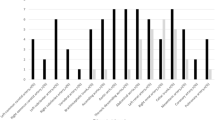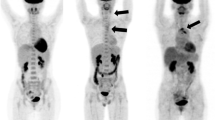Abstract
18F-fluorodeoxyglucose positron emission tomography/computed tomography (18F-FDG PET/CT) has become useful for the detection and diagnosis of inflammatory conditions, including rheumatic diseases, immunoglobulin (Ig) G4-related disease and giant cell arteritis. However, few articles based on small sample sizes (n = 7) diagnosed as adult-onset Still’s disease (AOSD) have been published. The study aim was to observe the reliable characteristics and usefulness of 18F-FDG PET/CT for the evaluation of consecutive patients with AOSD. Eligible patients were selected from among those who had undergone 18F-FDG PET/CT between May 2007 and June 2014. Twenty-six consecutive AOSD patients were recruited retrospectively according to criteria set by Yamaguchi et al. All patients underwent evaluation by 18F-FDG PET/CT. The characteristics and usefulness of 18F-FDG PET/CT for evaluation of consecutive patients with AOSD were evaluated. All 26 patients had 18F-FDG-avid lesion(s) related to their particular disease. Diffuse and homogeneous accumulation of 18F-FDG was seen in the bone marrow (26/26; 100 %; maximum standardized uptake (SUVmax), 2.10–6.73) and spleen (25/26; 96.15 %). The SUVmax of affected lymph nodes was 1.3–9.53 (mean ± SD, 4.12 ± 2.24). The SUVmax and size factors (maximum diameter and areas) of affected lymph nodes were significantly different (P = 0.033 and P = 0.012, respectively). 18F-FDG PET/CT showed the general distribution of 18F-FDG accumulation. This factor helped to exclude malignant disease and aided the diagnosis of AOSD (42.3 %) in 11 cases when combined with clinical features and aided decisions regarding appropriate biopsy sites, such as the lymph nodes (n = 9) and bone marrow (n = 13). 18F-FDG PET/CT is a unique imaging method for the assessment of metabolic activity throughout the body in subjects with AOSD. Characteristics or patterns of AOSD observed on 18F-FDG PET/CT can be used for the indication and diagnosis or to guide the clinical management of ASOD.




Similar content being viewed by others
References
Mahroum N, Mahagna H, Amital H (2014) Diagnosis and classification of adult Still’s disease. J Autoimmun 48–49:34–37
Efthimiou P, Paik PK, Bielory L (2006) Diagnosis and management of adult onset Still’ s disease. Ann Rheum Dis 65:564–572
Besson FL, de Boysson H, Parienti JJ, Bouvard G, Bienvenu B, Agostini D (2014) Towards an optimal semiquantitative approach in giant cell arteritis: an (18)F-FDG PET/CT case–control study. Eur J Nucl Med Mol Imaging 41:155–166
Gupta P, Ponzo F, Kramer EL (2005) Fluorodeoxyglucose (FDG) uptake in pulmonary rheumatoid nodules. Clin Rheumatol 24:402–405
Moreno D, Yuste JR, Rodriguez M, García-Velloso MJ, Prieto J (2005) Positron emission tomography use in the diagnosis and follow up of Takayasu’s arteritis. Ann Rheum Dis 64:1091–1093
Blockmans D, de Ceuninck L, Vandershueren S, Knockaert D, Mortelmans L, Bobbaers H (2006) Repetitive 18F-fluorodeoxyglucose positron emission tomography in giant cell arteritis: a prospective study of 35 patients. Arthritis Rheum 55:131–137
Takahashi H, Yamashita H, Morooka M, Kubota K, Takahashi Y, Kaneko H, Kano T, Mimori A (2014) The utility of FDG-PET/CT and other imaging techniques in the evaluation of IgG4-related disease. Joint Bone Spine 81(4):331–336
Yamaguchi M, Ohta A, Tsunematsu T, Kasukawa R, Mizushima Y, Kashiwagi H et al (1992) Preliminary criteria for classification of adult Still’s disease. J Rheumatol 19:424–430
Gerfaud-Valentin M, Maucort-Boulch D, Hot A, Iwaz J, Ninet J, Durieu I, Broussolle C, Sève P (2014) Adult-onset still disease: manifestations, treatment, outcome, and prognostic factors in 57 patients. Medicine (Baltimore) 93:91–99
Kurasawa M, Kotani K, Kurasawa G, Shida K, Yamada S, Tago T (2007) Adult-onset Still’s disease in a patient over 80 years old successfully treated with low-dose methotrexate therapy. Age Ageing 36:104–106
Ichiki H, Shishido M, Nishiyama S (1992) Two cases of adult onset of Still’s disease in the elderly. Nihon Ronen Igakkai Zasshi 29:960–964
Mavragani CP, Spyridakis EG, Koutsilieris M (2012) Adult-onset still’s disease: from pathophysiology to targeted therapies. Int J Inflamm 2012:879020
Nagai Y, Hasegawa M, Okada E, Hattori T, Tago O, Ishikawa O (2012) Clinical follow-up study of adult-onset Still’s disease. J Dermatol 39:898–901
Bagnari V, Colina M, Ciancio G, Govoni M, Trotta F (2010) Adult-onset still’s disease. Rheumatol Int 30:855–862
Nishiyama Y, Yamamoto Y, Dobashi H, Kameda T (2010) Clinical value of 18F-fluorodeoxyglucose positron emission tomography in patients with connective tissue disease. Jpn J Radiol 28:405–413
Glaudemans AW, de Vries EF, Galli F, Dierckx RA, Slart RH, Signore A (2013) The use of (18)F-FDG-PET/CT for diagnosis and treatment monitoring of inflammatory and infectious diseases. Clin Dev Immunol 2013:623036
Yamashita H, Kubota K, Takahashi Y, Minamimoto R, Morooka M, Kaneko H, Kano T, Mimori A (2014) Clinical value of 18F-fluoro-dexoxyglucose positron emission tomography/computed tomography in patients with adult-onset Still’s disease: a seven-case series and review of the literature. Mod Rheumatol 24:645–650
de Graaff LC, ten Broek MR, Schweitzer DH (2012) Is Still’s disease still one disease? A case of adult-onset Still’s disease showing accumulation in the carotids and the large vessels of the legs on positron emission tomography: CT images. Rheumatol Int 32:2487–2490
Funauchi M, Ikoma S, Kishimoto K, Shimazu H, Nozaki Y, Sugiyama M, Kinoshita K (2008) A case of adult onset Still’s disease showing marked accumulation in the liver and spleen, on positron emission tomography-CT images. Rheumatol Int 28:1061–1064
Choe JY, Chung DS, Park SH, Kwon HH, Kim SK (2010) Clinical significance of 18F-fluoro-dexoxyglucose positron emission tomography in patients with adult-onset Still’s disease: report of two cases and review of literatures. Rheumatol Int 30:1673–1676
Murata Y, Kubota K, Yukihiro M, Ito K, Watanabe H, Shibuya H (2006) Correlations between 18F-FDG uptake by bone marrow and hematological parameters: measurements by PET/CT. Nucl Med Biol 33:999–1004
Paes FM, Kalkanis DG, Sideras PA, Serafini AN (2010) FDG PET/CT of extranodal involvement in non-Hodgkin lymphoma and Hodgkin disease. Radiographics 30:269–291
Cremers JP, Van Kroonenburgh MJ, Mostard RL, Vöö SA, Wijnen PA, Koek GH, Drent M (2014) Extent of disease activity assessed by 18F-FDG PET/CT in a Dutch sarcoidosis population. Sarcoidosis Vasc Diffuse Lung Dis 31:37–45
Oh JR, Song HC, Kang SR, Yoo SW, Kim J, Chong A, Min JJ, Bom HS, Lee SS, Park YW (2011) The clinical usefulness of (18) F-FDG PET/CT in patients with systemic autoimmune disease. Nucl Med Mol Imaging 45:177–184
Dong MJ, Zhao K, Liu ZF, Wang GL, Yang SY, Zhou GJ (2011) A meta-analysis of the value of fluorodeoxyglucose-PET/PET-CT in the evaluation of fever of unknown origin. Eur J Radiol 80:834–844
Nilegaonkar S, Karekar R, Hirawe D, Lagade S (2012) Adult onset Still’s disease: role of scintigraphy. Indian J Nucl Med 27:48–49
Takeshita T, Kaminaga T, Ohkuma M, Furui S (2006) Adult-onset Still’s disease: evaluation by gallium-67 citrate scintigraphy. Intern Med 45:937–938
Acknowledgments
This study was supported by the National Natural Science Foundation of China (No. 81471704), the Science and Technology Planning Project of Zhejiang Province (2013C33119) and the Health Bureau Project of Zhejiang Province (2013KYA069, 2013ZDA008).
Conflict of interest
None.
Author information
Authors and Affiliations
Corresponding author
Additional information
Meng-Jie Dong and Cai-qin Wang contributed equally to this work.
Rights and permissions
About this article
Cite this article
Dong, MJ., Wang, Cq., Zhao, K. et al. 18F-FDG PET/CT in patients with adult-onset Still’s disease. Clin Rheumatol 34, 2047–2056 (2015). https://doi.org/10.1007/s10067-015-2901-6
Received:
Revised:
Accepted:
Published:
Issue Date:
DOI: https://doi.org/10.1007/s10067-015-2901-6




